The words "ornamental iron" immediately conjure images of ornate gates, railings with decorative scroll work and a blacksmith's anvil. Schouten Metalcraft, Inc. started that way. Founder John "Joop" Schouten was born in Holland and grew up working in his father's blacksmith shop, where he learned the art of shaping metal and the joy of working with his hands. The family emigrated and eventually settled in Indianapolis, where John worked together with son Ron for 25 years before passing the business on to him.
Today, owner Ron Schouten, son Paul and other metal workers still practice old-world craftsmanship-with the addition of some very modern welding equipment. Joop's original anvil still graces the shop, but it sits between two welders from Miller: a Millermatic® 252 with digital meters for MIG welding steel and a Millermatic 350P for pulsed MIG welding on aluminum.
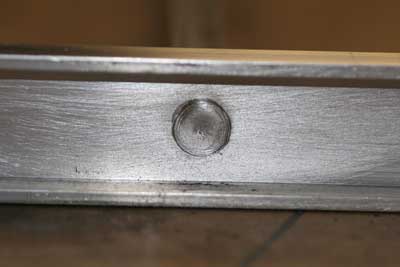 |
| When the operator lets go of the trigger, the Millermatic 350P automatically
ramps down to a cooler welding parameter to end the weld, preventing crater
cracks and creating beads with a TIG-like appearance. |
Schouten Metalcraft has learned that using both conventional and pulsed MIG technology shaves 16 to 24 hours off the welding time of a large project and reduces overall fabrication time by at least 50 percent. This provides a potential ROI of 101 percent and payback time of less than 12 months (see Fig. 1 for calculations). As a result increased aluminum efficiency, the company can adapt to market trends, reduce delivery time and still compete for price-driven customers ordering from catalogs.
"Now that we can pulsed MIG weld aluminum instead of TIG welding it, we can offer aluminum railings at almost the same price as steel, and in the same design," says Ron Schouten. He explains that labor costs are the key difference. Even though raw steel costs less than aluminum, steel requires more welding and sandblasting before painting.
Schouten notes that the demand for aluminum railings has recently surged. "Aluminum railings, when powder coated and painted, are almost maintenance-free. They're very durable and experience no rust issues compared to steel."
Schouten adds that aluminum products don't just include railings. They include almost any item that can be imagined-even a high-end aluminum dog kennel.
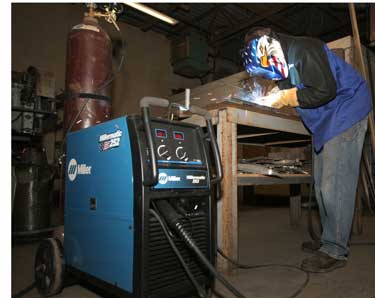 |
| The Millermatic 252's digital meters enable metalworker Tommy Harris to
easily set and return to his favorite voltage and wire feed speed parameters. |
Have it your Way
Schouten Metalcraft's major competitor isn't other metalworkers. Its Internet sites and catalogs offering prefabricated products made overseas at rock-bottom prices. Schouten notes that some are inferior quality, but some are also very serviceable.
"A lot of times when we do custom work, it's because somebody wants something copied or blended into a new design. They bring in a picture, or they see some of our samples, and then we design just for them," he says. "One of the ways we control costs is by blending quality prefabricated components with our custom-fabricated components. Modest homeowners get a custom product at an affordable price."
Of course, Schouten Metalcraft still builds totally unique products for discerning, upscale clientele, and it can use completely prefabricated components for cost-conscious customers. In almost all cases however, the welding requirements and challenges remain the same.
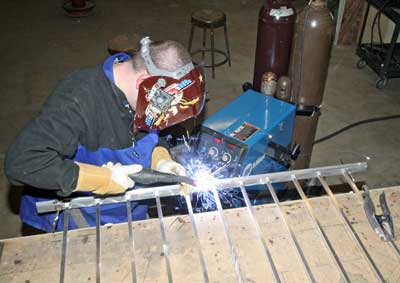 |
| Using the pulsed MIG output of this Millermatic 350P welder improved
Schouten Metalcraft's productivity by 50 to 75 percent compared to TIG welding. |
What Needs Welding
In its simplest form, a railing consists of:
- Balusters, or the vertical pickets, typically a 1/2-in. square bar stock (hot rolled steel or solid extruded aluminum).
- Lower and upper rails; 1- to 1-1/2-in.-wide and 1/8-in.-thick.
- A molded cap rail covering the top channel bar stock, typically about 1/4-in.-thick at the weld point.
- Decorative scrolls.
Schouten Metalcraft's workers punch holes in the bottom and top rail, spacing the holes less than 4-in. apart (railings used for safety purposes must comply with a code which states that a 4-in.-diameter sphere, which represents the size of small child, cannot fit through any part of the railing).
"For cosmetic purposes, we like to make a plug weld from underneath the rail," says Schouten. "However, the point where the baluster gets inserted into the hole in the lower rail creates an area where water pools. There's no issue with aluminum, but on a steel railing, water promotes rust, so we also need to weld steel joints from the top. We have to weld completely around the baluster and eliminate any pinholes."
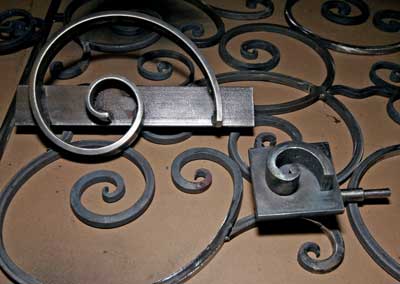 |
| "I have a tendency to make a die or jig for everything I do so my parts come
out very consistently," says Kory Didier, a metalworker formerly with Schouten
Metalcraft. |
Although this additional welding increases the labor cost associated with a steel railing, steel railings were still more affordable than aluminum railings because Schouten Metalcraft, like many fabricators concerned with aesthetics, used the TIG process when welding aluminum.
Unfortunately, while TIG welding creates beautiful weld beads and requires minimal clean-up, it is many times slower than MIG welding. On a small project, the extra TIG time isn't as much of an issue, but on a big project, it's cost prohibitive. Such was the case two years ago when Schouten Metalcraft needed to weld a main deck railing and balcony railings for a guesthouse.
"That project called for more than 200 linear feet of aluminum railing," recalls Ron Schouten. Because this amount of railing required approximately 1,200 plug welds, "TIG welding wasn't economical, so we called Steve Werner, our representative from Sutton-Garten Welding Supplies & Gases. As soon as we described our application to Steve, he said, 'You need a pulsed MIG welding machine.'"
Werner recommended the Millermatic 350P with a push-pull gun. Miller designed this unit to provide smaller fabricators with an operator-friendly pulsed MIG system at an affordable price point (2009 street price of approximately $5,600 when ordered with a 25-ft. XR-Aluma-Pro™ gun).
"I had never MIG welded or pulse MIG welded before in my life, but within a two- or three-day time period, I was comfortable with it because the Millermatic 350P was so easy to learn," says Paul Schouten. "After a week or two, I got really good with it and had fine tuned my settings for all our applications."
The Millermatic 350P is much more user-friendly than competitive machines because its control panel doesn't have confusing knobs and toggle switches. To begin pulsed MIG welding, operators simply select the built-in program that matches the wire type and size, and the unit automatically sets the pulse parameters. Operators then set the desired arc length; after that, they only need to adjust wire feed speed to weld a different thickness of metal (faster speeds for aluminum up to 1/2-in. thick, slower speeds for aluminum as thin as 19 gauge).
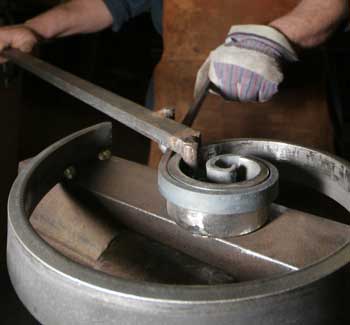 |
| A bending iron - two pins set into a piece of bar stock - is a simple
tool for making scrolls. To make a bending iron, drill a hole of the
exact same size as the pin you want, heat the area around the hole,
hammer the pin in and weld the backside to hold the pin in place. |
The Right Products
Werner notes that primary power availability is the first criteria to evaluate when determining which welder to recommend. "Schouten Metalcraft has single-phase power service," he notes. "Coupled with their need for simplicity, reliability and performance-especially on arc starts-that usually means I recommend a Millermatic...in this case, the Millermatic 252 for steel and the Millermatic 350P for aluminum."
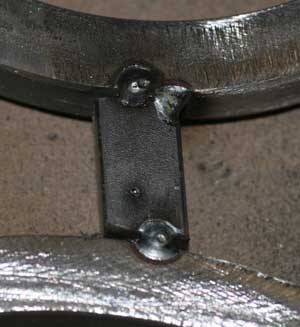 |
|
Tack weld components in position as you place them.
If necessary, tack weld both sides before finish welding to help
prevent warping. Also to prevent warping, consider finish welding
on alternating sides or otherwise skipping around the component
to evenly distribute the heat.
|
Not that Ron Schouten needed any convincing to purchase either of these machines; the company has owned Miller welders for decades, including a vintage Millermatic 200 and a used XMT® 304 acquired as a bargain.
"Miller welders have been very reliable," he says. "We need reliability as a small shop. We have to be very efficient, and we don't want any downtime."
Schouten notes that the new Millermatic 252 (which offers a 250 amp output at 40 percent duty cycle) features digital displays that make it very easy for everyone in the shop to dial in the voltage and wire feed speed settings they prefer. He also notices the unit provides very positive arc starts.
Steve Werner offers the technical explanation, saying that, "The Millermatic 252 features a built-in digital timer menu for setting wire feed run-in speed. Fine turning run-in speed, the speed at which the wire approaches the weldment before an arc is struck, lets fabricators tailor arc starts for their application."
The timer menu also provides a simple way to control shielding gas pre/post flow times, wire burnback rate and spot/delay times (the latter is used to set repeatable tack welding parameters and ensure consistency, notably in motorsports applications, which require thousands of welds per car).
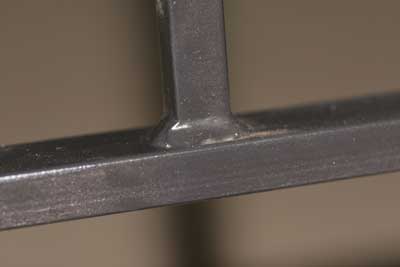 |
| On steel railings destined for exterior applications, Schouten Metalcraft welds all
sides of a joint to eliminate an area where water could pool and propagate rust.
The extra effort now reduces future maintenance costs. |
The Aluminum Solution
For welding aluminum with conventional spray transfer MIG, Schouten Metalcraft could have added an industrial-grade spool gun to its Millermatic 252 at a cost of about $1,000. However, welding aluminum 1/8-in. or thinner with spray transfer MIG requires a lot of skill, as this high-heat process often creates burn-through on thinner materials. Moreover, the weld bead aesthetics don't compare well to the TIG process to which Schouten Metalcraft is accustomed.
Conversely, pulsed MIG welding easily enables users to create weld beads with a TIG-like appearance (and little to no spatter) because pulsed MIG provides more control over the weld puddle. It also reduces and better controls overall heat input, enables all-position welding and improves productivity.
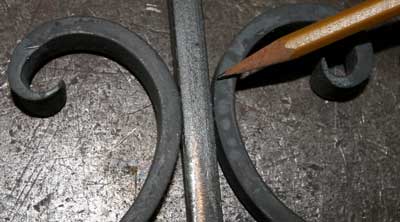 |
| Where scrolls come against a flat (as indicated by the pencil), or where two
scrolls come together creates an acute angle. To ensure good paint coverage,
Schouten Metalcraft hand-puddles primer in each of the joints. |
"When looking for a more productive alternative to TIG aluminum welding, pulsed MIG welders such as the Millermatic 350P usually provide the best solution," says Werner.
The Millermatic 350P provides a 25 to 400 amp welding output and features built-in programs for welding with 4000 and 5000 series aluminum (as well as mild steel, stainless steel and metal cored wires). To further improve performance, the Millermatic 350P now features an adjustable Aluminum Pulse Hot Start™ program designed to eliminate cold starts when welding aluminum (cold starts can lead to incomplete fusion). Aluminum Pulse Hot Start automatically provides more welding power at the start of the weld and then reduces power to normal parameters for optimal welding characteristics from start to finish.
Werner notes that, "In aluminum applications with short welds and a lot of stops and starts, lack of fusion at the start of the weld can be an issue with conventional MIG processes. With pulsed MIG, however, the pulse of peak current helps eliminate fusion issues, while the cooler background current helps prevent burn-through and warping."
 |
| Something old, something new-Schouten Metalcraft owner
Ron Schouten uses traditional tools, such as the anvil handed
down from his father, as well as state-of-the-art tools,
such as this Millermatic 350P for pulsed MIG welding on aluminum. |
Leaps and Bounds Ahead
Paul Schouten says that, "pulsed MIG welding aluminum is leaps and bounds ahead of TIG when it comes to welding speeds. I pulse MIG welded a fence with 193 pickets, which means 386 plug welds, in exactly eight hours. That project, which had 17 sections of railing each about 45 inches long, would have taken me three or four days to TIG weld."
Ron Schouten tempers this statement by adding that, "pulsed MIG welding does require a little bit more clean-up versus TIG, so you have to factor that into in as well. I'd say pulsed MIG reduces our overall fabrication time by 50 to 75 percent, depending on the job."
By clean-up, he refers to the company's practice of blending in the welds on the cap rail to make them appear seamless and to prep them for painting. Both aluminum and steel railings require clean-up with a flap disc and vibrating sander. Aluminum weld beads, however, first require some additional preparation with a grinding tool. But even with that additional time, there's no way Paul Schouten would go back to TIG welding on large projects.
"It would just take forever to hand feed filler wire into hundreds of plug welds," he says. "With pulsed MIG, we point the gun and just pull the trigger."
Miller Economic Evaluation Summary: Millermatic 350P/XR-Aluma-Pro Upgrade
Fig. 1-Potential Pulsed MIG Cost Savings
|
1. Estimated Annual Savings (present minus proposed costs*)
|
$8,000
|
|
2. Welding Investment (estimated street price)
|
$5,600
|
|
3. Annual Depreciation (Line 2 divided by 5 years)
(assumes straight line depreciation)
|
$1,120
|
|
4. Annual Savings After Depreciation (Line 1 minus Line 3)
|
$6,880
|
|
5. Profit After Taxes (66% of Line 4)
|
$4,540.80
|
|
6. Annual Cash Savings (Line 5 plus Line 3)
|
$5,660.80
|
|
Return on Investment (Line 6 divided by Line 2 X 100)
|
101%
|
|
Payback Period (Line 2 divided by Line 6 X 12 months)
|
11.87 months
|
*Potential cost savings calculated by:
- Reducing total fabrication time by 16 hours (50 percent) per aluminum project by switching from TIG to pulsed MIG.
- Assuming a typical overhead rate of $25/hour (16 hours x $25/hour = $400).
- Assuming 20 aluminum projects annually (20 x $400 = $8,000).